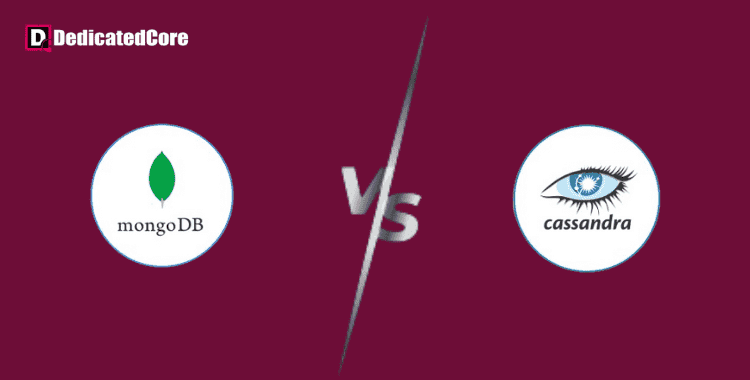NoSQL systems have gained significance in the changing database landscape. Because they handle enormous volumes of unstructured data. There are two prominent competitors in this space: Cassandra and MongoDB.
Get it clear about their benefits and drawbacks. This will help you make the best choice for your unique requirements. We will get in detail one by one the major differences and basic understanding of both. Here we will understand Cassandra vs MongoDB in detail.
Overview of Cassandra:
A distributed NoSQL database with exceptional scalability, Cassandra was created by Apache. Its decentralized architecture provides smooth horizontal scaling and fault tolerance. Cassandra highly is used in the finance and telecommunications sectors. Which requires high availability and fault tolerance. It is notable for its resilient performance in scenarios involving a lot of writing.
Overview of MongoDB:
In contrast, MongoDB is well known for having a document-oriented structure. This NoSQL database is a favorite among developers since it is flexible and easy to use. Adopting a JSON-like syntax for data storage. MongoDB is regularly the preferred option for projects. Especially that call for flexibility and rapid iterations. These kinds of projects are common in industries like content management and e-commerce.
Cassandra
The wide-column store data model is used by Cassandra. Tables with rows recognized by keys are used to organize the data. Perfect for applications that need a lot of reading and writing. It performs well when managing big data sets with fast queries.
Designed for seamless horizontal scaling. Because of its masterless architecture, which enables node addition. Without the need for a single point of failure. it works well in distributed and scalable infrastructures.
Follows the CAP theorem’s eventual consistency paradigm, giving availability and partition tolerance priority. Because fault tolerance is sacrificed in favor of rapid consistency. It is appropriate in situations when high availability is crucial.
Queries using CQL (Cassandra Query Language), a language akin to SQL. Supports indexing for efficient data retrieval. Well-suited for applications with simple querying needs.
Performs well in write-intensive situations like event logging, time-series data, and real-time analytics. Used in sectors where fault tolerance and scalability are crucial. Sectors such as finance, telecommunications, and the Internet of Things.
Benefits of Cassandra:
- Scalability: Smooth horizontal scalability is a feature of Cassandra’s design. Because of its distributed architecture, which supports the addition of nodes. It is a good fit for applications with increasing user loads and data volumes.
- High Availability: Cassandra guarantees high availability even in the event of node failures. Failure of network partitions thanks to its masterless architecture. The support for multi-data center replication.
- Fault Tolerance: One of the reasons Cassandra is fault-tolerant is because of its decentralized architecture. Multiple nodes replicate data, lowering the possibility of data loss in the event of hardware failures.
Drawbacks of Cassandra:
- Sophisticated Querying: Compared to conventional relational databases. Cassandra’s query language, CQL, could be restrictive for sophisticated queries. Aggregations and joins are more complicated.
- Learning Curve: Setting up and maintaining a Cassandra cluster can be difficult. Also difficult as calls for a solid grasp of distributed systems. NoSQL database beginners may find the learning curve to be quite high.
MongoDB
Adopts a document-oriented data model utilizing BSON (Binary JSON). Data is kept in adaptable documents that resemble JSON. It is appropriate for a variety of dynamic data formats. Perfect for applications that need dynamic schema and a high degree of flexibility.
Scalable both ways whereas horizontal scaling comprises spreading data over several servers. Vertical scaling involves expanding the capacity of a single server. Because of its flexible architecture, it helps. MongoDB can scale to meet the demands of various applications.
Embraces a robust consistency paradigm, ensuring immediate consistency. It reduces availability in the event of network partitions. A decision between high availability and strong consistency is made. It is based on the needs of the application.
Has an extensive query language that enables sophisticated searches and indexing techniques. Documents that resemble JSON and dynamic schema facilitate flexible querying. Makes it appropriate for a range of applications requiring different kinds of data retrieval.
Ideal for applications with dynamic data structures, e-commerce sites, and content management systems. It is a well-liked option for projects requiring adaptation to shifting data requirements because of its versatility and simplicity of usage.
Benefits of MongoDB:
- Adjustable Schema: Dynamic and adaptable schemas are possible with MongoDB’s document-oriented data format. This makes an excellent choice for projects involving changing or unpredictable data structures.
- Ease of Use: MongoDB is well-known for being easy to use. It requires less initial setup and is developer-friendly. Developers will find its JSON-like documents easy to work with.
- Rich Query Language: Complex queries, indexing, and secondary indexing are all possible with MongoDB’s robust query language. Applications with a variety of query requirements benefit from this flexibility.
Drawbacks of MongoDB:
- Consistency Policy: Due to its strict consistency policy, MongoDB may not be available in situations when there are network outages. Users must carefully weigh the requirements for consistency.
- Write Performance: Although MongoDB works well in many situations, it might not be able to match the write throughput of specialist databases such as Cassandra, especially in situations when the write loads are very high.
Conclusion
The specific needs of your project will determine which of Cassandra and MongoDB to use. While MongoDB is a great option for dynamic and changing data demands due to its flexibility and ease of use. Cassandra performs best in write-intensive, fault-tolerant circumstances. In the Final words while wrapping up this hope you got the clear idea.
To choose the best option for your NoSQL database, consider the team’s experience. The scalability requirements of your project, and its priorities. Hope you got a clear idea about Cassandra vs MongoDB.

